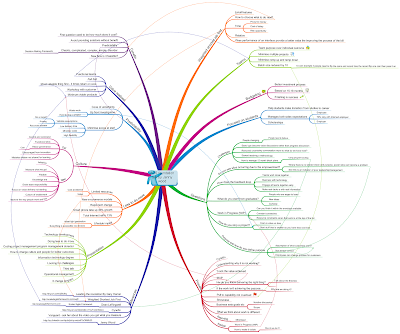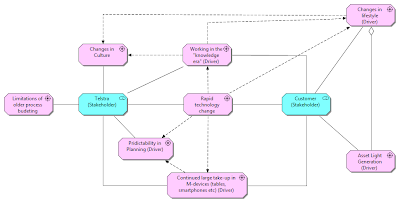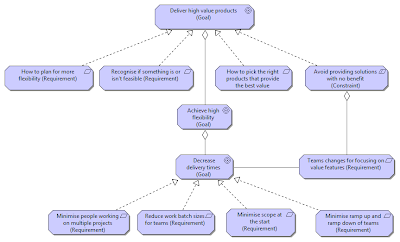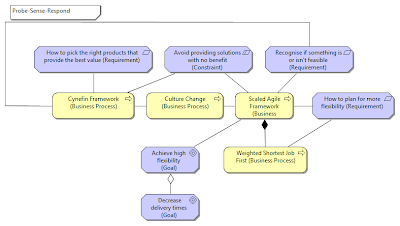On Thursday 23rd May the ACS Foundation hosted Jenny Wood, Director IT, Products & IT Enablement Telstra Corporation presenting 'Doing Less to Do More'. The talk was to provide students, local businesses and ACS members an opportunity to see how Telstra is currently changing and the potential value of working at Telstra. Of the students I talked to they were interested at looking at a combination of potential scholarships and also some were looking at potential PhD opportunities as well. Unfortunately I did not have a chance to talk to many afterwards to get their thoughts.
I was there because I saw "Telstra, Lean, Agile" in the title of the upcoming events and so I grabbed the opportunity to have a listen to one of Telstra's leaders describe agile in the enterprise environment. I was very happy that I did as it lead me to meeting some very interesting people and some great information which is why it has been almost a week and I have yet to get through all the knowledge leads. I created a mind map of the talk:
 |
| Figure 1 - MindMap for ACS Talk by Jenny Woods |
The foundation of Jenny's talk in my mind was how do you deliver more value with less waste and how do you change the workforce with new goals. This is the essence of Lean (Lean start ups Lean Logistics, Lean Development, "Lean Etc"). With this goal in mind, Jenny outlined the key influencing methods, processes and tools that Telstra is adopting to achieve this goal. She also highlighted some of the many challenges that face Telstra:
- Rapid technology change
- Continued large take-up in M-devices (tables, smartphones etc)
- Changes in lifestyle
- Working in the "knowledge era"
- A new generation known as the Asset Light Generation
- Within Telstra there is the migration of old to new cultures
- Education of new methodologies
- Older style budgeting models
- Predictability in planning
 |
| Figure 2 - Challenge drivers and stakeholders relationships |
We can see from this model the challenges are not just faced by the company but by the customer as well. How do customers cope with the same drivers, and what are their needs as a result. Obviously a company needs to address these drivers and Jenny highlighted a number of ways that Telstra is approaching these:
- Deliver high value products
- Minimise scope at the start
- Decrease delivery times
- Minimise costs
- Achieve high flexibility
- Avoid providing solutions with no benefit
- Recognise if something is or isn't feasible
- Reduce work batch sizes for teams
- Minimise ramp up and ramp down of teams
- Minimise people working on multiple projects
- How to plan for more flexibility
- How to pick the right products that provide the best value
- Teams changes for focusing on value features
Here I have modeled their associations between goals to requirements as I interpret them from the talk.
 |
| Figure 3 - Goals and realised requirements |
There are a number of strategies and process frameworks that Jenny outlined for Telstra to realise this change. Jenny did describe that Telstra has had its success and failures in applying the frameworks but is constantly learning from their mistakes.
- Cynefin for addressing predictability and decision making
- Scaled Agile Framework (SAF) for a common agile methodology
- Weighted shortest job first for prioritisation
- Culture change
 |
| Figure 4 - Goals, requirements, and business processes |
The Cynefin Framework is quite interesting, it is a decision making process, where you establish within what zone you are, and then pick an appropriate strategy accordingly to move to a more desirable state. One aspect I was interested to see in it was the concept of probing for solutions when you are in the complex environment. The "Spike" in agile is the equivalent, if you don't know if something can be done, is feasible or what might be involved, you add a spike story to an iteration. This is in essence real-time R&D work, and I really like the fact that this probe-sense-respond mechanism not only answers the requirements portrayed but builds up knowledge along the way for both team members and companies.
The Scaled Agile Framework (SAF) is one of a number of scaled agile frameworks out there and I personally like the way it addresses some of the architecture questions, though I don't think it has all the answers. It does include the Weighted Smallest Job First principle and on that Jenny posed the question "Does the performance of an interface provide a better value to the customer using the account web page than improving the processing of the bill?" (paraphrased). Assuming there are 2 problems, A) the page load time of a customers bill is slow, B) the processing of the bill itself is cumbersome and could be improved. The customer only sees the poor functionality of problem A, but not of problem B. Problem A is a smaller task to fix, while the cumbersome process may be costing the business money, poor customer experience has direct impact on revenue. Fixing the web site problem is also likely to be cheaper then overhauling the bill processing procedure. Its a faster win. Its a cheaper win. It doesn't mean problem B is never fixed, but it is not the priority so long as it continues to deliver the bill processed on time.
This ties back to Figure -2 where both the customer and Telstra are dealing with rapid changes and recognising what is the value drivers for both stakeholders. I am sure there where more in the talk I was nibbling on the lunch at the time. All of these processes do take alot of culture change. I have been through it, I have had friends who had had to deliver it, and I have had to deliver it at times and changing peoples attitudes to something can be difficult. Jenny described the current cultures in Telstra as:
Old Culture
|
New Culture
|
|
|
To summarise one of Jenny's points, project management success, rather then being defined as "on time, within budget, and in scope" needs to be re-positioned along the lines of "delivering a high value product, or stopped with minimal waste". This sort of change requires changes in how people are evaluated, how projects are measured, when stop points are defined. I was talking with Nick about Business value a few weeks ago and he was mentioning an example for a project in another company where the BV was being tracked. At a mid point in the project the value droped below the story points delivered due to a revaluation by stakeholders of some of the stories. This is a clear indication that the project needs to stop and decide, whether to pivot into a new direction, or cease completely etc. Why waste money if you are not delivering value?
The questions asked were interesting, and you can see these and their answers on the mind map, they are on the green branch. On the whole I enjoyed the lunch and the talk and am looking forward to the next one.
References
- Leading the revolution By Gary Hamel
- Weighted Shortest Job First
- Scaled Agile Framework
- Cynefin
- Jenny Wood
- ACS Foundation
- ACS